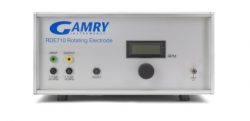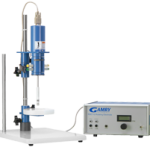Hydrodynamic Working Electrode
A rotating disk electrode (RDE) is a hydrodynamic working electrode used in a three electrode system. The electrode rotates during experiments making a constant flux of analyte to the electrode. These working electrodes are used in electrochemical applications such as corrosion studies, fuel cell research, catalyst development and controlling
mass transport of reactants to the electrode surface.
Rotating disk experiments are performed where defined mass transport to the sample electrode is desired. An example of this type of experiment would be catalyst evaluation.
The disk’s rotation is usually described in terms of angular velocity. As the disk turns, some of the solution described as the hydrodynamic boundary layer is dragged by the spinning disk and the resulting centrifugal force flings the solution away from the center of the electrode. The solution flows up, perpendicular to the electrode, from the bulk to replace the boundary layer. The sum result is a laminar flow of solution towards and across the electrode. The rate of the solution flow can be controlled by the electrode’s angular velocity and modeled mathematically. This flow can quickly achieve conditions in which the steady-state current is controlled by the solution flow rather than diffusion. This is a contrast to still and unstirred experiments such as cyclic voltammetry where the steady-state current is limited by the diffusion of species in solution.
By running linear sweep voltammetry and other experiments at various rotation rates, different electrochemical phenomena can be investigated, including multi-electron transfer, the kinetics of a slow electron transfer, adsorption/desorption steps, and electrochemical reaction mechanisms.
Rotating cylinder experiments are important in the oil industry to simulate the corrosion environment inside a pipeline, thus avoiding the need to assemble expensive flow loop setups. The rotator is an ideal tool because flow conditions at the rotating cylinder are generally turbulent even at low rotation rates. Cylinders can be made from a variety of different metals to evaluate their performance including 1018 carbon steel, 316 stainless steel, and 430 stainless steel. Users can machine cylinder samples using their actual material.
Rotating ring-disk electrodes are used where products generated at the disk electrode are monitored at the ring electrode. A bipotentiostat is required for these types of experiments.
Gamry RDE710 Rotating Electrode
 Providing steady-state control of constant rotation rates, the Gamry RDE710 Rotating-Disk Electrode also offers outstanding acceleration/deceleration control for applications where the rotation rate must be modulated.
Providing steady-state control of constant rotation rates, the Gamry RDE710 Rotating-Disk Electrode also offers outstanding acceleration/deceleration control for applications where the rotation rate must be modulated.
The ‘base’ rotation rate may be manually adjusted from 100 to 10,000 RPM by turning a ten-turn potentiometer knob located on the front panel of the unit. As the knob is turned, a built-in ‘tachometer’ measures the actual rotation rate. This rate is continuously displayed on the front panel of the control unit.
When the RDE710 is connected to a potentiostat system, a more complex control of the rotation rate is possible provided the  potentiostat is capable of supplying an analog rotation rate signal.
potentiostat is capable of supplying an analog rotation rate signal.
The rotator is able to accurately follow complex waveforms and create the desired rotation rate response by using a high rate, low inertia, permanent magnet DC motor in combination with a high voltage, bipolar power supply.
For information on HydroFlex® – the only electrode measuring directly the activity of Hydrogen ions visit Reference-Electrode.info.
